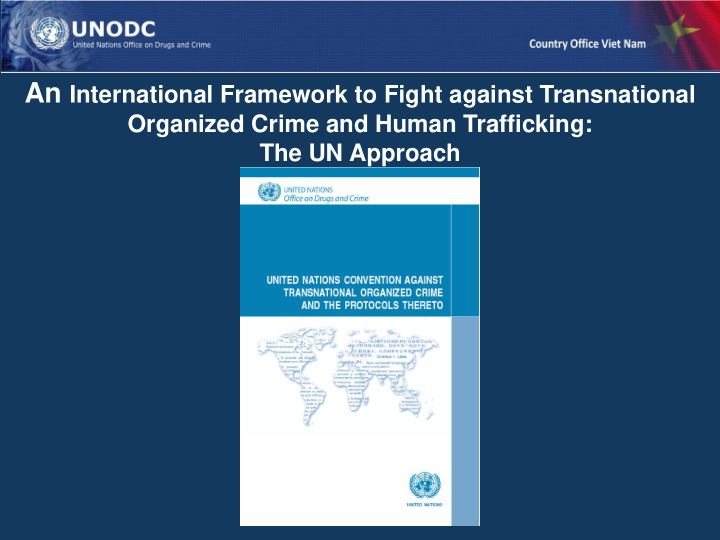



An International Framework to Fight against Transnational Organized Crime and Human Trafficking: The UN Approach
Approaching universal ratification UNTOC and its protocols – As of 21 August 2013 United Nations Convention against Transnational Organized Crime – Status: entered into force 29 September 2003 – Parties 177 – Signatories 147 Protocol to Prevent, Suppress and Punish Trafficking in Persons, Especially Women and Children – Status: entered into force 25 December 2003 – Parties 157 – Signatories 117 Protocol against the Smuggling of Migrants by Land, Sea and Air – Status: entered into force 28 January 2004 – Parties 137 – Signatories 112
Structure of Convention Defines and standardizes terminology Requires States to criminalize specific conducts Specific control measures (money-laundering, corruption etc.) Confiscation of proceeds of crime Cooperation Training, research, information measures Prevention Technical provisions (signature, ratification etc.)
Key obligations for State Parties* • Criminalization • Prevention, Investigation and prosecution • International cooperation
Criminalization – Offences established by the convention (Art. 5, 6, 8 and 23) – Other serious crimes defined in Art.2 – Protocol offences (Protocols, Art.1) • when: – transnational in nature – an organized criminal group is involved
Criminalization: Participation in an organized group • Organized criminal group shall mean a structured group of three or more persons, existing for a period of time and acting in concert with the aim of committing one or more serious crimes or offences established in accordance with this Convention, in order to obtain, directly or indirectly, a financial or other material benefit (Article 2a, UNTOC) • Comment: the definition of an “organized criminal group” is central to its operation. The definition of “organized criminal group” does not include groups that do not seek to obtain any “financial or other material benefit”.
Criminalization Laundering of proceeds of crime (art.6) “Proceeds of crime” shall means any property derived from or obtained, directly or indirectly, through the commission of an offence. (art. 2e UNTOC) Comment: If the legislature wants to ensure coverage of proceeds of crime, where these are located outside the State’s territorial jurisdiction, it may be useful to clearly state that proceeds of crime can include proceeds located offshore
Criminalization: Corruption (art.8)
Criminalization Obstruction of justice (Art. 23) The use of physical force, threats or intimidation or the promise, offering or giving of an undue advantage to induce false testimony or to interfere in the giving of testimony or the production of evidence in a proceeding in relation to the commission of offences covered by this Convention (a) The use of physical force, threats or intimidation to interfere with the exercise of official duties by a justice or law enforcement official in relation to the commission of offences covered by this Convention (b)
Prevention, i nvestigation & prosecution International cooperation • Purpose of the Convention is to promote cooperation to prevent and combat transnational organized crime (Article 1 UNTOC) • Mutual legal assistance • Extradition • Law-enforcement cooperation • Technical assistance and training.
Relation of the Convention with the Protocols: Any protocol to this Convention shall be interpreted together with this Convention, taking into account the purpose of that protocol (Art. 37.4 UNTOC) The provisions of the Convention shall apply, mutatis mutandis, to the Protocols, unless otherwise provided therein (Art. 1 TIPP and SOMP)
Transnational Organized Crime and the Protocol to Prevent, Suppress and Punish Trafficking in Persons
Traff afficki icking ng in in Pe Persons ns (TIP) P) Pr Protocol ocol • The protocol provides concise definition of trafficking cking in pers rson ons and the constituent elements of the crime (Article 3) “Trafficking in persons shall mean the recruitment, transportation, transfer, harbouring or receipt of Persons by means of threat or use of force or other forms of coercion, of abduction, of fraud, of deception, of the abuse of power or of the position of vulnerability or of the giving or receiving of payments or benefits to achieve the consent of a person having control over another person, for the purpo pose se of exploitation…..”
TI TIP P Pr Protoco col l – El Elements ts of Hu Human Tr Traffic fickin king • The definition involves three basic elements namely: – ACT CTION ION of trafficking , – MEANS NS of trafficking and – PUR URPOS OSE of trafficking
SOM Protocol – Smuggling of Migrants “Smuggling of migrants” shall mean the procurement, in order to obtain, directly or indirectly, a financial or other material benefit, of the illegal entry of a person into a State Party of which the person is not a national or a permanent resident.
SOM Protocol – Elements of Smuggling of Migrants SMUGGLING OF MIGRANTS Procurement For financial or Across a border of illegal entry other material gain into another state
Differences between trafficking in persons and smuggling of migrants Consent Exploitation Transnationality Victim Source of profit
STRUCTURE OF THE PROTOCOL GENERAL PROTECTION OF VICTIMS PREVENTION FINAL PROVISIONS OF TRAFFICKING IN COOPERATION PROVISIONS PERSON AND OTHER MEASURES Article 5(2)(a) Article 6 Article 9 Criminalization Assistence to and protection Prevention of trafficking in persons of victims of trafficking in persons Article 7 Article 10 Status of victims of Information exchange and training trafficking in persons in receiving States Article 8 Article 11 Repatriation of victims of Border measures trafficking in persons Article 12 Security and control of documents Article 13 Legitimacy and validity of documents
AVAILABLE TOOLS
Thank you! United Nations Office on Drugs and Crime Viet Nam Country Office minh.nguyen@unodc.org
Recommend
More recommend